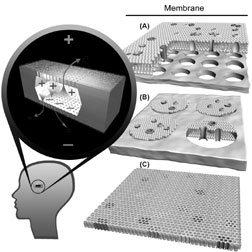| Nanotechnology, prosthetics | |
Nano-size battery for artificial retina31 January 2006 Albuquerque, N.M., USA. A new research centre is to be established at the University of Illinois Urbana-Champaign to develop nanomedical devices based on cell ion transporters. The first project will be to develop bio-batteries for implantable devices, the first of which is an artificial retina developed at the University of Southern California. A five-year, $6.5 million grant has been awarded by the National Eye Institute of the National Institutes of Health (NIH) to establish a new center, the National Center for Design of Biomimetic Nanoconductors. Based at the University of Illinois Urbana-Champaign under the direction of principal investigator Eric Jakobsson, the center is designed to rapidly launch revolutionary ideas in the use of nanomedicine. The center will design, model, synthesize, and fabricate nanomedical devices based on natural and synthetic ion transporters — proteins that control ion motion across the membranes of living cells. The first task for the center will be to design a class of devices for
generating electric power — bio-batteries — for a wide array of implantable
devices, starting with an artificial retina that has already been developed
at the Doheny Eye Institute at the University of Southern California. The
artificial retina and accompanying nanobattery will be used to correct
certain types of macular degeneration. Several researchers from Sandia National Laboratories, led by principal investigator Susan Rempe, are part of the multi-institutional, multidisciplinary team. Sandia’s role is on the theoretical and computational side of the project. Sandia is a National Nuclear Security Administration laboratory. “We will use our expertise in multi-scale modeling to understand and predict how transporter structure leads to function, with an initial focus on specialized transporters found in the electric eel,” said Rempe. “This information will give us a better understanding of how power is naturally created in biological organisms — information to be used for designing and building the nanobattery.” Working on another aspect of the project is Jeff Brinker, who is
affiliated with both Sandia and the University of New Mexico. He will
engineer components of the bio-battery using silica technology. Sandia is one of the center’s participants, as are the Doheny Eye Institute at the University of Southern California, the Illinois Institute of Technology, Purdue University, the University of California-Davis, the University of Illinois at Ubana-Champaign, Oxford University (UK), Wabash College, and Weill Medical College of Cornell University. The National Center for Design of Biomimetic Nanoconductors is part of a package of about $43 million for four advanced national centers in nanomedicine announced this year under the NIH’s New Pathways to Discovery Program. The NIH programme began in 2003 as a Roadmap for Medical Research initiative to spur medial research discoveries from bench to bedside. The other centers will be at the Baylor College of Medicine in Houston, the University of California at San Francisco, and Columbia University in New York City. Links Sandia National Laboratories: http://sandia.gov/index.html The National Center for Design of Biomimetic Nanoconductors
|
